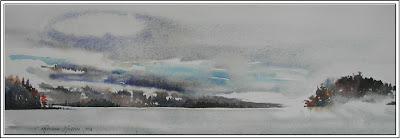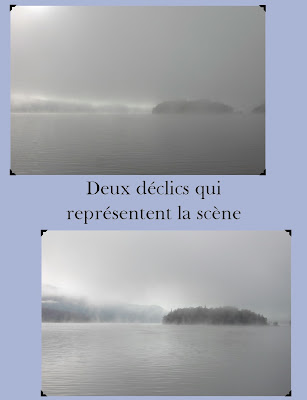

"Morning Fog and Reflection, LTN"
Le matin, j’aime m’installer au bord d’un lac afin d’observer et peindre l’effet du brouillard. Je me lève très tôt afin de me préparer avec pinceau, pigments et papier prêt à capter l’effet atmosphérique qui sera de courte durée.
Par un matin brumeux, mon amie a documenté en photo non seulement le levé de soleil mais aussi quelques étapes de ma peinture en évolution. Comparez les photos de la scène avec celle peinte. La photo capte un très court moment. Moi, je fais une synthèse d’un phénomène atmosphérique. Voilà, je crois, la différence entre une œuvre artistique et la photo statique.
 "Golden Fog Lifting, Lac Tremblant Nord"
"Golden Fog Lifting, Lac Tremblant Nord"
Il faut une mémoire pour créer –tel que le suggère l’écrivain et critique d’art, John Berger. L’appareil photo ne possède pas le même type de mémoire que l’humain. La caméra n’enregistre qu’une fraction de seconde. Pendant les quelques vingt minutes que je peins le brouillard je réfléchis et j’interprète. Je développe mon aquarelle à l’aide de la même matière qui se transforme devant moi, de l’eau. C’est le médium idéal selon moi pour peindre ce sujet. Et, avec émotion et sentiments face à ce phénomène en mouvement, je place au fur et à mesure de la couleur sur le papier.

Je ne crois pas que je pourrais faire le même exercice en studio à partir de la photographie de la scène. Vaudrait mieux tenter de peindre la scène de mémoire sans aucune référence photo.

Les étapes :
1. Je mouille la partie supérieure de la feuille à partir de l’horizon jusqu’en haut. Donc, je travaille d’abord mouillé dans mouillé ciel et terre.
2. Lorsque j’ai peint une grande partie du ciel et la brume qui se diffuse sur les îles je laisse les pigments s’entremêler. Puis, je commence à peindre la section du bas, le lac. Je travaille cette partie plutôt mouillé sur sec. Il est impératif de réserver du papier non peint entre lac et terre. Autrement les couleurs des deux parties se fusionneront et je ne pourrai pas rendre l’effet blanc et lumineux entre lac et montagne.
3. Je peins des traits parfois minces parfois plus larges. Ceux-ci représentent couleur et valeur du mouvement des vagues. Entre ces lisières humides et teintées, je réserve le papier sec afin de distinguer eau colorée et reflet blanc.

4. Au fur et à mesure que le pigment s’imbibe dans le papier à l’étape du mi-humide je dépose de l’eau claire entre ces bandes de couleur afin qu’elles s’entremêlent partiellement les unes dans les autres. Finalement, il faut savoir quand s’arrêter. Si je reviens au mauvais moment dans une section fraîche et humide, l’aquarelle sera ratée.

"Brume du matin, Lac Tremblant Nord"
Je ne peins pas le brouillard, mais plutôt un événement atmosphérique ressenti.
*Selected Essays by John Berger, edited by Geoff Dyer
Raynald Murphy sca



























